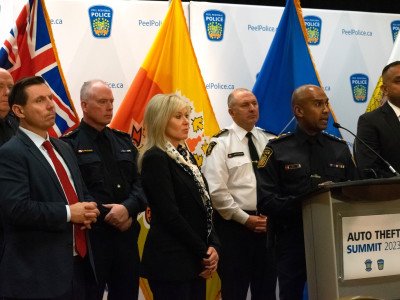“There’s no way to splinter off auto theft, there’s no way to just isolate auto theft. Auto theft has found its way into all major crime, including organized crime.”
Those were the words of Matt Miller, a detective sergeant in intelligence services with Peel Regional Police (PRP) nearly a year ago, during what became an annual event to address auto theft in the region and across the province.
“We’re looking at a multimillion-dollar organized crime investigations problem [and] in one term, as has been bantered around: an absolute crisis,” he told a room filled with police officers, elected officials, industry experts and stakeholders from all corners of the province.
A year later, headlines declare: “Peel resident facing 168 auto crime charges” and “Peel Region is Ontario’s auto theft capital,” reporting 1,433 carjackings between Brampton and Mississauga since the start of 2024. The ominous news signals the growing severity of these crimes. According to the Insurance Bureau of Canada, a baseline estimate over the last decade of 90,000 vehicles are reported stolen annually (or one car every six minutes) across the country.
While auto theft itself is not a new phenomenon, the nature of the crime has shifted. What once was a petty crime has turned into a staple of syndicated activity organized by sophisticated rings operating with little concern for international borders.
The stealing of vehicles is now fueling a range of criminal enterprises.
Rates across the GTA have been surging in recent years with carjackings increasing at an alarming pace. Since 2020, the Region of Peel has seen a 145 percent increase in auto thefts, according to Peel police data. Those are just the reported cases. As auto theft has evolved from a common street level activity to a funding stream for increasingly complex organized crime, police departments province-wide have called for more collaboration by provincial and federal leaders.
“The ability to shift from just taking [a vehicle] from the driveway to acts of violence is a concern to us,” PRP Chief Nishan Duraiappah told reporters a month ago during the first federal summit to address auto theft. “The rates provincially in Ontario of carjackings and violence associated to the theft of vehicles is growing right across the province.”
Peel police Chief Nishan Duraiappah is facing an auto theft crisis on his watch.
(Alexis Wright/The Pointer Files)
It has been a year since stakeholders across the province gathered for Peel’s inaugural Auto Theft Summit in March 2023 to address the disturbing increase in auto theft rates — marking the first time police, government and representatives from the auto sector came together to discuss ways to combat auto theft and raise awareness about the growing issue.
Peel was described as a “cash cow of organized crime”.
PRP deputy chief Nick Milinovich previously revealed auto theft is one of the top revenue generators for organized crime, only behind drugs and fraud, and the majority of the theft in Canada is originating in Ontario, particularly in the GTA. During the 2023 Summit, he acknowledged as the severity increases, the reality of auto theft “isn’t an issue that any one service really can or should address on its own” and is one that has become “cross-jurisdictional… interprovincial [and] transnational.” He previously estimated revenue generated from auto theft-related crime to be as high as a billion dollars annually.
“It’s not joyriding anymore, it’s lucrative and revenue-generating.”
A report commissioned by the Canadian Finance and Leasing Association acknowledged “these sophisticated offences have become more prevalent and international in scope,” adding “there is no single solution to vehicle theft because it is a multi-dimensional and jurisdictional problem.” It noted solutions would require collaborative efforts from all levels of government and stakeholders, warning that “vehicle theft will continue exacerbating without coordinated multi-jurisdiction initiatives involving public and private stakeholders.”
Recognizing there would be no overnight solutions, a primary focus of the 2023 summit was the need for improved multi-sectoral collaboration between agencies to reduce auto thefts everywhere, not just in Peel. Three sets of recommendations were agreed upon from the summit: invest and enhance collaboration between police agencies; establish a multi-sector working group to identify solutions; and raise public awareness and increase prevention campaigns.
Key priorities brought forward in the 2023 summit included the formation of a multi-jurisdictional Joint Forces Unit. It would make it easier for police organizations in different cities to coordinate enforcement efforts and investigations into large auto-theft networks that often span multiple cities, with success contingent on federal and provincial investments into coordinated efforts to track and disrupt illegal exports of stolen vehicles. Other priorities identified at the summit included establishing a broad executive working group among stakeholder industries and organizations to increase public awareness about how to protect the public against auto theft.
Has anything changed?
According to data from Peel police, last year saw 8,279 known auto thefts — a record for the region — up from 6,042 in 2022 and from 3,376 in 2020. From 2018 to 2022, auto theft across the province increased nearly 90 percent, with over 27,800 vehicles reported stolen in Ontario in 2021 representing an average of 75 vehicles per day. In Peel alone, there was a 118 percent increase during that same four-year period. Similar trends were seen in other major jurisdictions across the province including Durham, Halton, Toronto and Ottawa. Police have repeatedly attributed these spikes to the pandemic which created a strained supply chain and economic hardships — factors that coalesced into push factors for auto thefts.
A report from Criminal Intelligence Service Canada noted that from 2021 to 2022, three of the main police services in the GTA — Toronto, York and Peel — saw a combined 104 percent increase in carjackings. Chief Duraiappah recently suggested Peel Region may have the highest rate per capita of stolen vehicles, with roughly 600 a month, almost one an hour.
Leaders from across the political spectrum, from municipal to federal, gathered in February for the National Summit on Combatting Auto Theft to discuss auto theft on the national stage.
(X/Twitter)
Political leaders, police, border agents and auto industry executives convened at the National Summit on Combatting Auto Theft in February to discuss on a larger stage what has become a Canadian issue.
Funding announcements in the weeks leading up to the first national summit also indicated perceptions around the issue had changed.
In January, recognizing “auto theft is a growing problem and one that is increasingly violent,” Public Safety Minister Dominic LeBlanc announced the federal government would be investing $121 million over five years to target gun and gang violence in Ontario. With a specific focus on auto thefts in the GTA, where the numbers of carjackings have soared in recent years, the funds earmarked for Ontario are part of a larger federal investment of $390 million set aside by Ottawa in 2023 for the national initiative, Action Against Gun and Gang Violence.
Solicitor General Michael Kerzner told reporters during Ottawa’s January funding announcement that a task force has made 89 arrests, laid 554 charges and recovered more than 100 vehicles since it was formed last year.
Ontario Premier Doug Ford has not indicated how much money from Ottawa and Queen’s Park will flow to Peel. A second funding announcement was made a week later in February — a day ahead of the national summit — for $28 million for CBSA to increase the agency’s ability to detect and search containers at the border with stolen vehicles, as well as test available detection technologies.
Last May the PCs announced $51 million over three years to tackle organized crime networks through dedicated auto theft police and prosecution teams across the province.
The 2024 Auto Theft Summit is set to take place March 20 and, like last year, will be another joint-collaboration by Peel Regional Police, partnering police services, stakeholders from government and industry leaders, “to shed light on the challenges in public safety related to auto theft,” according to Peel police’s website. “More notably, it is to define real action and implement impactful solutions with partners in policing, government, and industry across Ontario and its communities.”
The need for increased measures comes as Peel police recently received an unprecedented 14 percent budget increase from the Region for 2024 to fund its operations — a budget request Duraiappah said is “necessary to get his team to a “breathing point.” The additional funding would allow the force to bring on 135 new officers — the biggest number in a single year — 80 percent of which would be dispatched to the frontlines with a focus on issues including auto thefts, the Chief explained to regional councillors in October.
While it’s unclear what the focus of next week’s summit will be, in a post on X the police force assured it has been “increasing the number of officers and expanding investigative resources into our Commercial Auto Crimes Unit,” which it says is one of the largest in Canada, and “enhancing our Criminal Investigative Bureaus in each of our divisions that serve Brampton and Mississauga, and participating in joint force operations with other law enforcement agencies across Ontario.” These efforts have “resulted in historical numbers of recovery of stolen vehicles, arrests, and charges of members of organized crime groups.”
The post states Peel police has “been leading the work on identifying solutions to vulnerabilities contributing to auto theft” with stakeholders, including government officials, auto manufacturers, the insurance industry and advocacy groups. The police force is also encouraging residents to consider anti-theft devices for vehicles, enhancing security at home through cameras and alarm systems, keeping key fobs away from doorways and entrances and decreasing visibility to vehicles by parking in garages.
While the force says progress is being made, it recognizes “there is still much more work to be done to fully dismantle auto theft.”
Email: [email protected]
Twitter: @mcpaigepeacock
At a time when vital public information is needed by everyone, The Pointer has taken down our paywall on all stories to ensure every resident of Brampton, Mississauga and Niagara has access to the facts. For those who are able, we encourage you to consider a subscription. This will help us report on important public interest issues the community needs to know about now more than ever. You can register for a 30-day free trial HERE. Thereafter, The Pointer will charge $10 a month and you can cancel any time right on the website. Thank you


